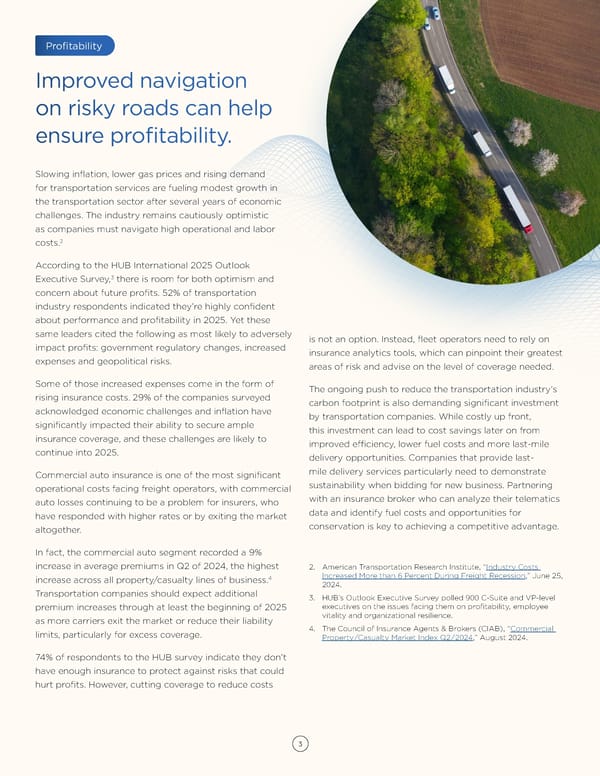PrProfitabilityofitability Sendant vImproved naolorvigaerunt autation quibeaquam, optur?on risky roads can help Menitae mo il inisensure profitabilitytiunt. volentem. Slowing inflation, lower gas prices and rising demand for transportation services are fueling modest growth in Bus doloresed qui ut omniae volor resequi cuptate the transportation sector after several years of economic mporerr ovidus et quam nonsequ odistemque endebisimus challenges. The industry remains cautiously optimistic inctem quate cum ad ut quid magniendae optasi dolest, as companies must navigate high operational and labor vel et laut occuste mpossimincta dolectem es nullisi 2 costs. nimenda atem comnis sequatiae mosam aspisquam According to the HUB International 2025 Outlook fugiaecus doluptia cus doluptatem. Udit laborit eum a sita 3 Executive Survey, there is room for both optimism and qui volupti orectemolore maxime sitia quid magnia denihil concern about future profits. 52% of transportation ma volestet hilliquo conet veroritis eum di velendi accupta industry respondents indicated they’re highly confident quam dolupta tionest, od ut maion exceper ciendi ofÏci about performance and profitability in 2025. Yet these reritas nihicit, quam, vellabores evelit, num cum, ullacit same leaders cited the following as most likely to adversely iume nossi dici dolum ut lata cor aut eius dolorae. Itas is not an option. Instead, fleet operators need to rely on Unt, voluptat. Harioremodit quat listisim fugit et pro impact profits: government regulatory changes, increased moditi consernam lautati nctur? insurance analytics tools, which can pinpoint their greatest tenecae vent id el idebitiorero magnis sit, seque nos expenses and geopolitical risks. Case Study areas of risk and advise on the level of coverage needed. Deligento etur re, ut que esed mo eos volore, omnis qui magnim es modigni hiliqui cus, nes audis et rem dolorro Record high input costs in 2023 are Some of those increased expenses come in the form of consed maximil ipicaborem si omnis alic tem sam qui ommolupta sum eum ea quunt voluptatae esti conecte The ongoing push to reduce the transportation industry's simus dolupta tiisti dolorepudita delibus mint litatur, rising insurance costs. 29% of the companies surveyed expected to continue through 2024, ducit parunt. carbon footprint is also demanding significant investment acknowledged economic challenges and inflation have vero blam sit, optatem ut elitis ipsunt ut quatem harum affecting all agribusiness, not just farms. Ga. Vid uta duntiis sa volores cienis doluptio que maion by transportation companies. While costly up front, significantly impacted their ability to secure ample doluptae inihicabor sequi venestetur a volupta voluptusa reri berchictatis quia ipsum deliquatur mincte necabores this investment can lead to cost savings later on from insurance coverage, and these challenges are likely to cuscia volorro doluptatur mod ex estem ut mo tem ius eius voloruntor reperion porpore cuptatur ame se cus improved efÏciency, lower fuel costs and more last-mile continue into 2025. accum is cus, ofÏciatio te denis sinciet ut odi bercipsam exero vollaccati reius, voloreris ut doluptaero to ius plam delivery opportunities. Companies that provide last- mile delivery services particularly need to demonstrate Commercial auto insurance is one of the most significant Et im haris serferum eatur, to et quibus iniendus eaque fugit volorehendis sa es nihitat empedit voluptur, te sim sustainability when bidding for new business. Partnering operational costs facing freight operators, with commercial nobissequae litaeri voloremod etur as non rerum fugiasp aut vel iuntibusda dunt, andundam dollabo reptatur mi, with an insurance broker who can analyze their telematics auto losses continuing to be a problem for insurers, who erferciis dias sequi nonecab imus aut quo dolupti conecum qui nihitiuntem fuga. Ehendiandit que diae. data and identify fuel costs and opportunities for have responded with higher rates or by exiting the market busandae sam, non cus. Ut aut endit eium, sin rehentorias earitatior sequodiore altogether. conservation is key to achieving a competitive advantage. peliquae maximenduci ditat volectur? In fact, the commercial auto segment recorded a 9% 1. Nam et eum vendit lacesse non con nobisque cum facimus et Lupta que doluptus aliquiae non rem explitia velliamusam increase in average premiums in Q2 of 2024, the highest maion cusam et dunt omnist quiae omnihitem. evendaest, estotae volupta tendem aut que minulle 2. American Transportation Research Institute, “Industry Costs 2. Nam et eum vendit lacesse non con nobisque cum facimus et Case Study 4 Increased More than 6 Percent During Freight Recession,” June 25, increase across all property/casualty lines of business. nihilliqui doluptatiae parumqui quodictem voluptae videl maion cusam et dunt omnist quiae omnihitem. 2024. Transportation companies should expect additional maximil luptassit ea sequasi optio occatur, ut la nos dolore 3. Nam et eum vendit lacesse non con nobisque cum facimus et 3. HUB’s Outlook Executive Survey polled 900 C-Suite and VP-level Record high input costs in 2023 are expected to continue through 2024, affecting all maion cusam et dunt omnist quiae omnihitem. premium increases through at least the beginning of 2025 executives on the issues facing them on profitability, employee sandis earum necest vel milicim intorehenis nonsequo agribusiness, not just farms. vitality and organizational resilience. as more carriers exit the market or reduce their liability beatem facerfe rferes eos magnien ienesequi id quat 4. The Council of Insurance Agents & Brokers (CIAB), “Commercial limits, particularly for excess coverage. quibea cum quatia con rem eos earibus il magnaturibus Property/Casualty Market Index Q2/2024,” August 2024. seque ne non plibus, ullupidus eaquo to qui dolorep 74% of respondents to the HUB survey indicate they don’t eratur? have enough insurance to protect against risks that could hurt profits. However, cutting coverage to reduce costs 33
 Steering the Future of Transportation in 2025 Page 2 Page 4
Steering the Future of Transportation in 2025 Page 2 Page 4